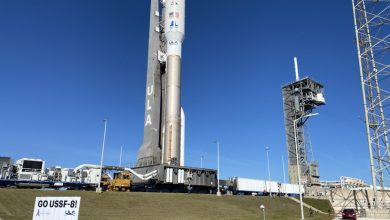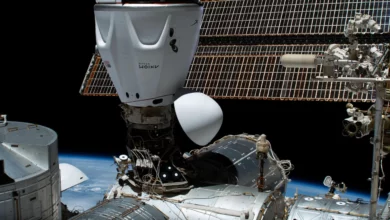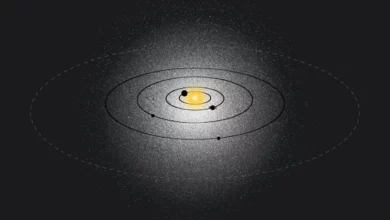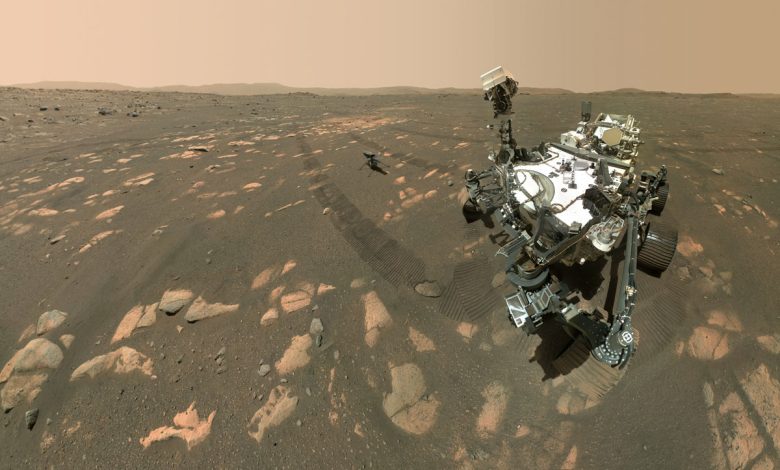
(Lead image: Perseverance looks at Ingenuity after deploying the helicopter onto the Martian surface. Credit: NASA/JPL-Caltech)
After the successful launch of three new Mars missions in the summer of 2020, Mars exploration was looking to have a groundbreaking year in 2021. Astonishingly, all three missions — NASA’s Mars 2020, China’s Tianwen-1, and the United Arab Emirates’ Hope orbiter — successfully arrived at Mars in February, and have already sent back amazing data and images of the red planet.
Furthermore, missions like NASA’s Curiosity rover and InSight lander celebrated various milestones on Mars this year and sent back amazing results and findings that helped further our knowledge of Mars’ past and future. While new missions were landing on the surface of Mars, missions in orbit, such as NASA’s Mars Reconnaissance Orbiter (MRO) and ESA’s Mars Express, continued to relay data to Earth and send back amazing images and science of their own.
The year 2022, like 2021, is already shaping up to be an amazing year on Mars, with new missions such as ExoMars 2022 with the Rosalind Franklin rover launching to the red planet, as well as new experiments planned to be performed by the collection of robots exploring the Martian wasteland.
Perseverance and Ingenuity
After a launch from Florida on July 30, 2020, NASA’s Mars 2020 mission, consisting of the Perseverance rover and Ingenuity helicopter, successfully landed in Jezero Crater on February 18, 2021, at 20:55 UTC. The mission landed on Mars via a skycrane that was nearly identical to the one used for Curiosity’s landing in 2012, and the mission’s landing location was named Octavia E. Butler Landing.
During entry, descent, and landing (EDL), Perseverance successfully captured stunning video of the entire EDL phase of the mission. The rover was also expected to collect sound via microphones attached to Perseverance, but the microphones ultimately failed during EDL. Although this isn’t the first time we’ve ever seen video of EDL from a spacecraft (Curiosity successfully captured video of its landing), Perseverance’s landing footage is the first to be in high-definition and captured from different angles.
After rover teams performed checkouts on the rover and its variety of instruments and electrical systems, Perseverance successfully took its first drive on Mars on March 4, 2021 — driving 6.5 meters (21.3 feet) across the Martian surface. The drive lasted 33 minutes. Additionally, in the weeks leading up to Perseverance’s first drive, many of its scientific instruments were deployed and calibrated for use.
After continuing vehicle calibrations and setups through March, early April was set to be the beginning of the Ingenuity helicopter’s flight test campaign. Ingenuity was successfully deployed from underneath Perseverance on April 3, 2021, and successfully survived its first night in the harsh Martian landscape that night.
Following a few issues and tests with the helicopter’s rotor blades, Ingenuity successfully flew on Mars for the first time on April 19, 2021 — becoming the first aircraft to ever make a powered, controlled flight on another planet. The flight lasted 39.1 seconds as the helicopter hovered 3 meters above the Martian surface.
Three days later, Ingenuity successfully performed its second flight on Mars. In an effort to perform five flights within its testing window, Ingenuity completed its third flight on April 25, fourth on April 30, and fifth on May 7, 2021.
On May 23, 2021, Ingenuity successfully performed its first flight under its Operations Demonstration Phase with its sixth overall flight. Under the Operations Demonstration Phase, Ingenuity would assist Perseverance with scientific observations by providing aerial imagery of potential areas of interest in Jezero Crater. Additionally, the flights within the Operations Demonstration Phase would push Ingenuity to its limit, and see the helicopter fly higher and farther than it had previously.
Ingenuity continues to fly regularly on Mars, averaging one flight about every two weeks. The helicopter was originally expected to only be able to complete five flights on Mars, but has since completed an incredible 18 flights — 13 more than originally expected. Ingenuity continues to operate and is in good condition to continue performing flights in 2022.
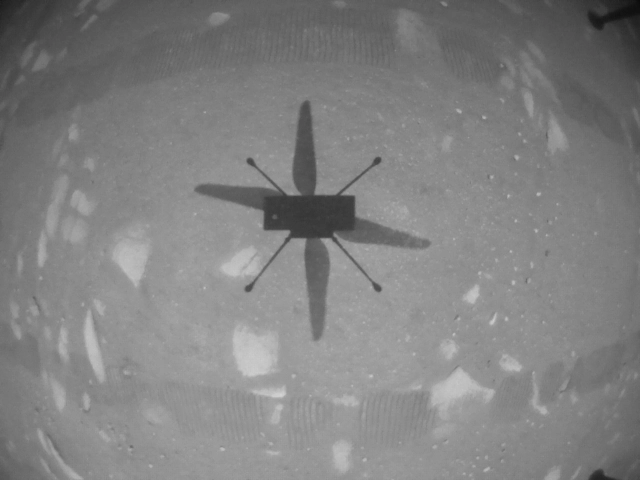
As Ingenuity was performing its first flights on Mars, Perseverance served as the helicopter’s communication to Earth. However, when the rover wasn’t acting as a communications base, Perseverance was performing scientific observations on Jezero Crater using its array of instruments and robotic arm.
On June 9, Perseverance completed its commissioning phase and officially began its first science campaign in Jezero Crater. This first science phase has seen Perseverance explore the Séítah and the Crater Floor Fractured Rough areas of Jezero Crater. These two areas are located south of the rover’s landing site. Perseverance will return to Octavia E. Butler Landing once complete with this first campaign in 2022 and will drive north, starting the rover’s second science campaign.
In mid-July, it was announced that Perseverance and its teams on Earth were preparing for the rover’s first sample collection attempt in the Cratered Floor Fractured Rough area. Teams attempted the first sample collection attempt on August 6, however, no sample was collected in the tube due to the Martian surface composition being weaker in the location the sample collection attempt occurred.
However, teams attempted another sample collection on a new rock, named “Rochette,” on September 1, and the rock sample was successfully drilled and collected by Perseverance’s sample collection system. This sample marked the first sample ever collected of Mars, and kicked off the Mars Sample Return initiative, wherein several samples of Mars collected by Perseverance are planned to be returned to Earth in the 2030s for analysis in a lab.
Since this first successful sample collection, Perseverance has gone on to collect four more samples, for a total of five total samples collected in 2021. Perseverance and its teams on Earth are already looking ahead into 2022 for potential sampling targets.
From October 2 to October 14, Perseverance and Ingenuity, along with all other actively operating spacecraft at Mars, ceased communication with Earth for Mars solar conjunction — an event in which Mars crosses behind the Sun from Earth’s vantage point, limiting communication with Martian spacecraft.
Perseverance now continues to rove around Jezero Crater with Ingenuity periodically flying alongside it.
When 2021 started, I was flying through space at over 50,000 mph/80,000 kph. One (Earth) year later, my land speed is definitely slower – but my pace of discoveries is only picking up. So much more to come: https://t.co/pT3fCGkL1i pic.twitter.com/nYn0w3DY3C
— NASA's Perseverance Mars Rover (@NASAPersevere) December 29, 2021
Tianwen-1
Alongside Mars 2020, China sent its first missions to Mars last year, successfully arriving and performing an orbital insertion burn around the planet in early 2021.
China’s Tianwen-1 launched atop a Long March 5 rocket on July 23, 2020, from the Wenchang Spacecraft Launch Site in China. After a seven month coast through space, Tianwen-1 successfully inserted itself into a stable Martian orbit on February 10, 2021.
Tianwen-1 consists of an orbiter, a lander, and a rover named Zhurong. After orbiting Mars for a little over three months, the entry capsule, containing the Tianwen-1 lander and Zhurong, separated from the orbiter on May 14, 2021. Soon after, the lander and the rover would successfully land on the surface of Mars at 23:18 UTC on May 14 — an incredible accomplishment for China to achieve with only their first mission to Mars.
Zhurong was deployed from the Tianwen-1 lander on May 22 at 02:40 UTC. The lander and Zhurong landed in the Utopia Planitia region of Mars, and Zhurong began exploring the areas surrounding itself and the lander in the days and weeks following its deployment.
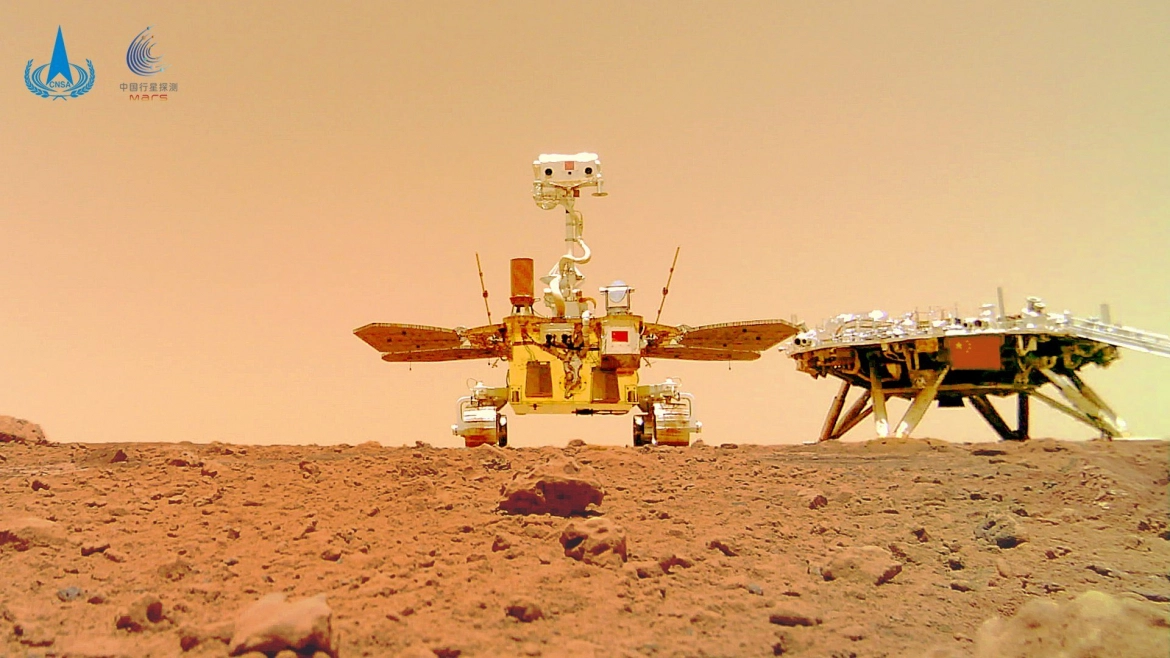
After spending the summer roaming around Utopia Planitia performing science and visiting various rocks and structures (such as its parachute and backshell), Zhurong successfully completed all of its planned exploration tasks on August 15. However, teams still planned to drive the rover until it could no longer function as expected. Like all other missions, Zhurong and Tianwen-1 briefly ceased communications and operations during Mars solar conjunction.
Zhurong continues to roam the surface of Utopia Planitia, and the Chinese National Space Administration, every so often, releases new images of Mars from the rover, as well as occasional selfies taken by a remote camera placed on the surface by Zhurong.
Emirates Mars Mission
The final new spacecraft to arrive at Mars in 2021 is the United Arab Emirates’ Al Amal (translates to “Hope” in English) orbiter. Al Amal is a part of the UAE’s Emirates Mars Mission and, like Tianwen-1, successfully launched in 2020 and arrived at Mars in early 2021.
Al Amal successfully launched atop a Japanese Aerospace Exploration Agency (JAXA) HII-A rocket on July 19, 2020, from the Tanegashima Space Center in Tanegashima, Japan. The orbiter successfully performed its orbital insertion burn at Mars on February 9, 2021, at 15:30 UTC after coasting through space for nearly seven months.
The primary goal of Al Amal is to study the weather and atmospheric conditions at Mars to gain a better understanding of how the planet functions. These goals make Al Amal Mars’ first true “weather satellite.”
Since arriving in orbit in February, Al Amal has sent back stunning images of Mars, and some scientists have already begun using data collected by the spacecraft in their research on the Martian atmosphere.
Al Amal’s mission is expected to last one Martian year, roughly 1,374 Earth days. However, should the orbiter be in good health and functioning properly, a mission extension could be awarded to the Al Amal teams.
On July 18, 2021, the EXI camera system onboard the EMM mission obtained a set of multispectral images of a fully-illuminated hemisphere of Mars – which looks very similar to observations routinely carried out by weather satellites orbiting Earth. pic.twitter.com/Uvq9A0jthu
— Hope Mars Mission (@HopeMarsMission) October 10, 2021
Curiosity
Curiosity continued exploring new areas and climbing hills on Mars in 2021, and celebrated its ninth year on the red planet on August 6, 2021. Additionally, the rover celebrated its 3,000th sol on Mars on January 12.
Launching in November 2011, Curiosity successfully landed via a skycrane in Gale Crater on Mars in August 2012. Curiosity began science operations soon after and has been exploring various outcrops and areas of interest in Gale Crater ever since. Furthermore, since 2014, Curiosity has been climbing the slopes of Aeolis Mons (Mount Sharp) — a massive 5.5 km (18,045 feet) mountain in the center of Gale Crater.
Curiosity continued climbing Mount Sharp this year — visiting various outcrops, rocks, outlooks, and slopes to perform science and investigate its surrounding area. The rover, using its robotic arm, successfully drilled into a variety of rocks, and performed a total of five drillings in 2021.
Curiosity started off the year driving across the “Glen Torridon” region towards a new location called the “sulfate-bearing unit.” While traveling toward the sulfate-bearing unit, Curiosity stopped at an area where the clay-bearing unit changes to the sulfate-bearing unit to investigate an outcrop dubbed Mont Mercou.
While at Mont Mercou, Curiosity investigated the outcrop’s sedimentary layers, imaged the outcrop in a variety of ways, successfully drilled its 30th drill hole, and took a selfie. While at Mont Mercou, Curiosity also managed to drive to the top of the outcrop and investigate the rocks and layers that could be seen at the top of the outcrop, as well as drill another drill hole.
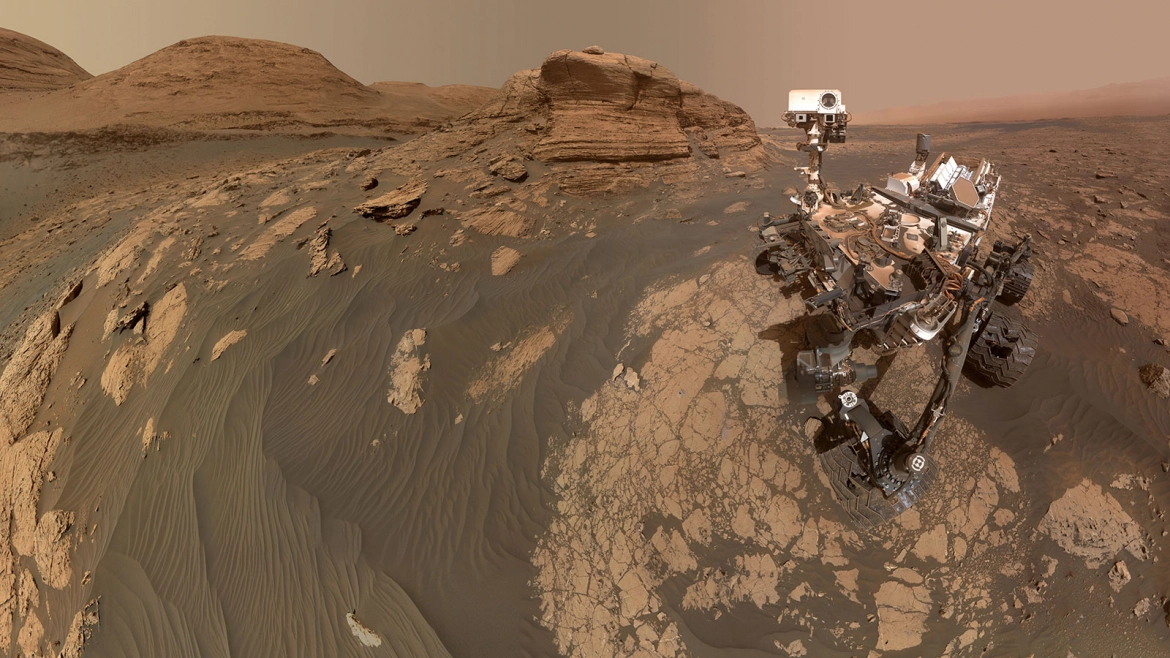
After completing its investigations at Mont Mercou, Curiosity began to drive up the slopes of Mount Sharp once again. Since leaving Mont Mercou, Curiosity has continued driving up the northwestern side of Mount Sharp, in an area where the surface materials are changing from clay-bearing to sulfate-bearing. While driving through this area, Curiosity stopped and drilled its 32nd drill hole.
In early September, Curiosity arrived at “Maria Gordon Notch,” a narrow passageway up Mount Sharp with towering cliffs on either side of the rover. Upon arriving in the area where the notch is, Curiosity stopped and successfully drilled its 33rd drill hole. In early October, Curiosity ceases surface operations for Mars solar conjunction.
Since arriving at Maria Gordon, Curiosity has been driving through the center of the notch and even stopped to drill its 34th drill hole and final drill hole of 2021. Curiosity will continue to make its way through the Maria Gordon Notch into 2022, and future routes up Mount Sharp and drill hole locations will be planned along the way.
InSight
When 2021 started, InSight and Curiosity were the only actively operating spacecraft on the surface of Mars. However, that has since changed, but just because new visitors have arrived doesn’t mean the work stops.
InSight launched in May 2018 from California and successfully landed in the Elysium Planitia region of Mars on November 26, 2018. InSight’s primary goal is to research the inner workings of Mars and better understand seismic activity in the Martian surface.
InSight’s 2021 kicked off with a bang, with it and NASA’s Juno spacecraft each being rewarded mission extensions at their respective planets.
Additionally, InSight’s “mole” instrument, after suffering issues with being buried into the Martian surface, was officially ended in January, and InSight stopped attempting to bury the instrument.
As the Martian winter kicked in, InSight’s solar panels were not receiving optimal amounts of power to support full surface operations in Elysium Planitia. Due to the reduced sunlight amounts during Martian winter and the amount of dust on the panels blocking sunlight, InSight’s teams implemented a plan in February to begin reducing the amount of surface operations InSight performs in an effort to maintain power and keep the lander safe.
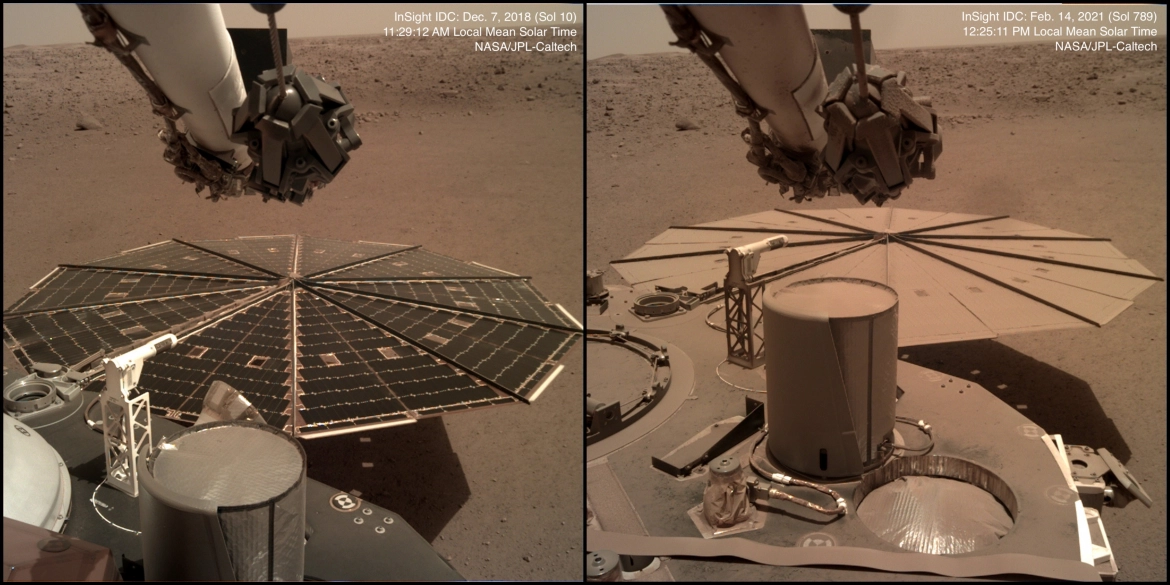
However, in early June, it was announced that the team had developed a technique that allowed InSight to clear dust off of its solar panels, increasing the amount of power available to the spacecraft. The technique involved InSight scooping up Martian soil and dumping it onto the top of the spacecraft. The wind would catch the soil grains as they fell onto the spacecraft and blow them across the solar panels, clearing certain areas on the panels. This technique has caused a gain of more than 30 watt-hours of energy per sol.
Additionally, in early April, InSight successfully detected two large “Marsquakes” in Elysium Planitia with its Seismic Experiment for Interior Structure (SEIS) seismometer instrument. The quakes, which originated in the Cerberus Fossae region of Mars, were 3.3 and 3.1 in magnitude — making these two quakes some of the strongest quakes InSight has ever recorded.
Throughout the summer, InSight continued to listen for quakes and use its various instruments to research the deep interior of Mars. On September 18, the lander celebrated its 1,000th sol on Mars, and celebrated by recording one of the largest quakes it had ever recorded — a 4.2 magnitude quake.
The September 18 quake was the third in a series of extremely strong Marsquakes InSight had recorded in the span of a month. On August 25, InSight recorded two massive quakes — one that was a magnitude of 4.2, and another that was 4.1 in magnitude. The August 25 and September 18 quakes became the strongest Marsquakes that InSight has ever recorded, taking the record from a 3.7 magnitude quake InSight recorded in 2019.
InSight, as with all other Mars missions, ceased operations in October for Mars solar conjunction. InSight continues to monitor and record Marsquakes in Elysium Planitia and is expected to continue researching and logging their origin and the deep interior of Mars.


